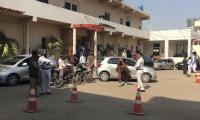fourth, Khyber-Pakhtunkhwa (KP) fifth, Sindh sixth, Balochistan seventh and, lastly, FATA at eighth spot.
Even though there was a drop of 3.6 percent in Balochistan’s score, FATA’s overall score improved by 15 percent.
Karachi stands at the 43rd place in terms of education nationally, followed by Hyderabad at 62 and Naushahro-Feroze in the 72nd spot. Their education scores for this year are 72.5, 67.3 and 63.6, respectively.
Infrastructure
Punjab stood first with the highest score of 86.9 in school infrastructure, followed by ICT with a score of 86.6.
KPK and Sindh maintained their third and fourth places, respectively, and scored 70.4 and 47. In fifth place is Gilgit-Baltistan, FATA, Balochistan and Azad Jammu Kashmir (AJK). However, the national school infrastructure score rose to 62.2 from 57.6 last year.
In this category, Karachi ranks 49 with a score of 72.2, followed by Larkana at 52nd place with a score of 70.3 and Shaheed Benazirabad at 55 with a score of 66.6.
Facing neglect
The report concludes that as the overall situation of education in Punjab and KPK improves, it continues to deteriorate in Balochistan and Sindh.
With Karachi being the only district scoring more than 70 in the education indicators, and the overall provincial score around 10 points below the national average, the findings attribute this status to governance failures on the provincial governments’ part.
Meanwhile, as the Sindh government claims to be serious in mitigating the education crisis in the province, two years after the passage of Free and Fair Education Act, the authorities have yet to frame the rules of business.
Without any rules of business to strategise the access to school and quality improvement for more than six million out-of-school children in the province, provision of free and fair education has become somewhat of a liability for the province.
This lack of direction reflects in the government’s management of education and the available resources.
Though the annual budget for education has been increasing consistently, the state of education in the province seems to stagnate, or worse, deteriorate, instead of improving, because of the misdirected allocations.
For the outgoing fiscal year, the Sindh government increased the education budget by 10 percent from last year, but most of the increase went toward salaries, while the development budget was reduced by at least 12 percent.
Eminent educationist Shahnaz Wazir Ali, who is also president of Szabist, believes that consolidation and collation of dynamic data, along with devolving education to districts would help the province improve quality and access to education.
“The policies do not reflect actual problems because they are made too far from where they are implemented,” she said, “There is a need to devolve education planning to the districts.”
Mazar-e-Quaid can be seen in this image in Karachi. — AFP/FileChoose Your WayThe Studio Seven Art Gallery is hosting...
The image shows people standing outside the an anti-terrorism court in Karachi. — APP/ FileAn anti-terrorism court ...
A photo from the session under Community Development Initiative funded by IREX on the importance of Sexual and...
A girl seen on a seesaw in an event organised by the Green Crescent Trust.— Facebook@gct.org.pk/File Over 800...
This representational image shows a gun and bullets. — Unsplash/FileKarachi's West Zone Police have been collecting...
This representational image shows a school student participating in a painting competition on February 20, 2024. —...







